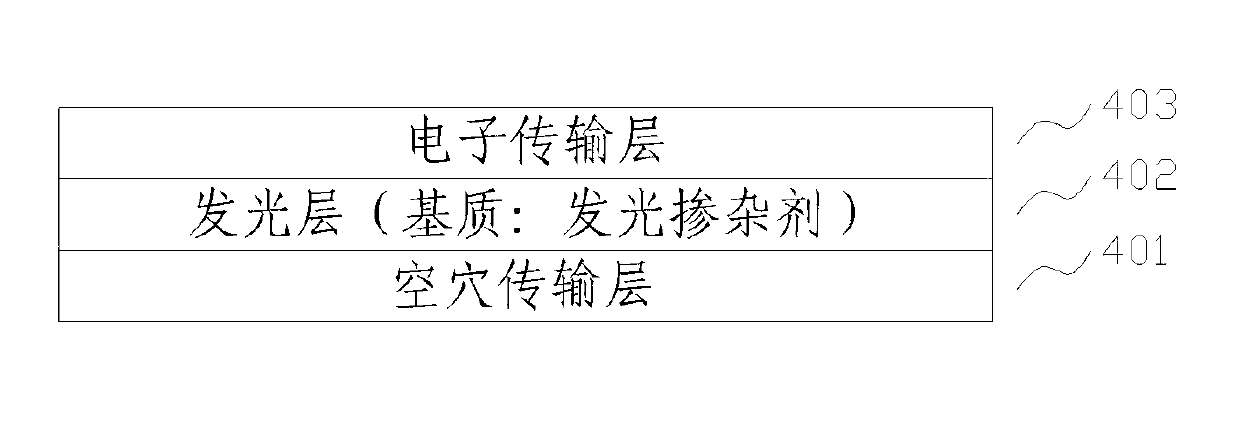Organic electroluminescent device
An electroluminescent device and luminescence technology, which is applied in the direction of electric solid-state devices, electrical components, semiconductor devices, etc., can solve the problems of poor universality and increased cost, and achieve the effect of improving performance
- Summary
- Abstract
- Description
- Claims
- Application Information
AI Technical Summary
Problems solved by technology
Method used
Image
Examples
Embodiment 1
[0033] The structure of the organic electroluminescent device A1 in this embodiment is:
[0034] A1: ITO / m-MTDATA (20nm) / NPB (50nm) / TCTA (10nm) / TCTA: TPBi: Ir(piq) 2 acac (7wt%, 20nm) / TPBi (20nm) / TPBi: Cs 2 CO 3 (10wt%, 10nm) / C60 (20nm) / CuPc (20nm) / m-MTDATA: F4-TCNQ (20wt%, 10nm) / NPB (40nm) / TCTA (10nm) / TCTA: TPBi: Ir(piq) 2 acac (7wt%, 20nm) / TPBi (30nm) / TPBi: Cs 2 CO 3 (10wt%, 20nm) / Al (100nm).
[0035] The structure of the organic electroluminescent device is as follows figure 1 As shown, a series structure is adopted as a whole, consisting of two light-emitting units 40 and a charge generating unit 50. The transparent conductive film ITO deposited on the glass substrate 10 is used as the anode 20 of the device, and Al is used as the cathode 70 of the device. A hole injection layer 30 and an electron injection layer 60 are evaporated respectively after the ITO and before the Al electrode to improve the injection of electrons and holes. T...
Embodiment 2
[0046] At the same time, an organic electroluminescent device B1 comprising a double light-emitting unit and a reference device B2 with a single light-emitting unit were prepared, and its specific structure was as follows:
[0047] B1: ITO / m-MTDATA (20nm) / NPB (50nm) / TCTA (10nm) / TCTA: TPBi: Ir(mdq) 2 acac (7wt%, 20nm) / TPBi (20nm) / TPBi: Cs 2 CO 3 (10wt%, 10nm) / C60 (20nm) / pentacene (20nm) / m-MTDATA: F4-TCNQ (20wt%, 10nm) / NPB (40nm) / TCTA (10nm) / TCTA: TPBi: Ir(mdq) 2 acac (7wt%, 20nm) / TPBi (30nm) / TPBi: Cs 2 CO 3 (10wt%, 20nm) / Al (100nm);
[0048] B2: ITO / m-MTDATA (20nm) / NPB (50nm) / TCTA (10nm) / TCTA: TPBi: Ir(mdq) 2 acac (7wt%, 20nm) / TPBi (30nm) / TPBi: Cs 2 CO 3 (10wt%, 20nm) / Al (100nm).
[0049] In this embodiment, C60 / pentacence is used as the charge generating layer, C60 is used as the charge generating auxiliary layer, and pentacene is used as the light-absorbing active layer. The device luminescent dopant is Ir(mdq) 2 acac. ...
Embodiment 3
[0052] At the same time, an organic electroluminescent device C1 comprising a double light-emitting unit and a reference device C2 with a single light-emitting unit were prepared, and its specific structure was as follows:
[0053] C1: ITO / m-MTDATA (20nm) / NPB (50nm) / TCTA (10nm) / TCTA: TPBi: FIrpic (7wt%, 20nm) / TPBi (20nm) / TPBi: Cs 2 CO 3 (10wt%, 10nm) / PTCDI-C8 (20nm) / Pentacene (20nm) / m-MTDATA: F4-TCNQ (20wt%, 10nm) / NPB (40nm) / TCTA (10nm) / TCTA: TPBi: FIrpic (7wt %, 20nm) / TPBi (30nm) / TPBi: Cs 2 CO 3 (10wt%, 20nm) / Al (100nm);
[0054] C2: ITO / m-MTDATA (20nm) / NPB (50nm) / TCTA (10nm) / TCTA: TPBi: FIrpic (7wt%, 20nm) / TPBi (30nm) / TPBi: Cs 2 CO 3 (10wt%, 20nm) / Al (100nm).
[0055] The charge generating unit of this embodiment adopts PTCDI-C 8 / Pentacene heterojunction, with pentacene as charge generation auxiliary layer, PTCDI-C 8 for the light-absorbing active layer. The light-emitting dopant of the device is FIrpic, a blue phospho...
PUM
| Property | Measurement | Unit |
|---|---|---|
| Thickness | aaaaa | aaaaa |
Abstract
Description
Claims
Application Information
 Login to View More
Login to View More - R&D
- Intellectual Property
- Life Sciences
- Materials
- Tech Scout
- Unparalleled Data Quality
- Higher Quality Content
- 60% Fewer Hallucinations
Browse by: Latest US Patents, China's latest patents, Technical Efficacy Thesaurus, Application Domain, Technology Topic, Popular Technical Reports.
© 2025 PatSnap. All rights reserved.Legal|Privacy policy|Modern Slavery Act Transparency Statement|Sitemap|About US| Contact US: help@patsnap.com



